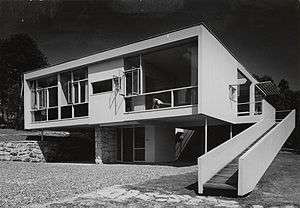Rose Seidler House
| Rose Seidler House | |
|---|---|
|
Rose Seidler House, Sydney, Australia, winner of the Sir John Sulman Medal in 1951 | |
| General information | |
| Type | House |
| Location | 71 Clissold Road, Wahroonga |
| Coordinates | 33°42′35″S 151°08′31″E / 33.7098°S 151.1419°ECoordinates: 33°42′35″S 151°08′31″E / 33.7098°S 151.1419°E |
| Construction started | 1949 |
| Completed | 1950 |
| Owner | Historic Houses Trust of New South Wales |
| Design and construction | |
| Main contractor | Harry Seidler |
Rose Seidler House is a Bauhaus-styled home designed by Harry Seidler located in a remote bushland site at 71 Clissold Road, Wahroonga, an upper north-shore suburb of Sydney, New South Wales, Australia.
The house was designed for both of Seidler's parents–Rose and Max Seidler[1] - but since Rose Seidler was the person who initiated and drove the commission, making all the main client decisions - the house is named after only her.
It is managed by the Historic Houses Trust of New South Wales (now called Sydney Living Museums) as a museum that has been open to the public each Sunday since 1991. Built in 1949-1950, it was futuristic and modern for Australia at that time, and is an outstanding example of mid-century-modern domestic architecture.
In 1991, Harry Seidler described the house's spatial design which was characteristic of his approach in the rest of his life's work:[2]
this house explodes the surfaces that enclose a normal house or space, and turns it into a continuum of free standing planes, through which the eye can never see an end, you are always intrigued what’s beyond, you can always see something floating into the distance, there is never an obstruction to your vision, it is a continuum (of space), that I believe 20th century man’s eye and senses responds positively to.
Following the example of the houses he had worked on in Breuer's office in 1946-48 which were located on compounds next to a public nature reserve in North-East USA, Seidler picked the site for the house because it was next to Ku-Ring-Gai Chase reserve. In 1948, the site had been used to mine pottery clay,[3] and was considered very remote - being at the end of a dirt road through market gardens.[4] It was long after the house was finished that the surrounding streets were paved and developed as a residential suburb.
There is a documentary "Frozen Music: Rose Seidler House and the Work of Harry Seidler" (2004) (22 minutes) - which screens on loop at Rose Seidler House during opening hours.
References
- ↑ The plans list client as M. Seidler–see plan in footage at 11-12 sec of online film entitled "Harry Seidler's 1950s houses - Wahroonga"
- ↑ "Rose Seidler House – the House that Harry built". Review. Australia: ABC TV. 14 April 1991.
- ↑ (pottery clay mining) Cassette "Rose Seidler House : furniture / Harry Seidler interviewed by Peter Watts (and Linda Rektor) about the furniture at Rose Seidler House - May 1987 [sound recording]" Caroline Simpson Library, The Mint, Sydney Living Museums, catalogue 749.20495 SEI. Transcript in suspension file.
- ↑ (site like Breuer houses and market gardens) Interview with Harry and Penelope Seidler on 12 May 2001 at Rose Seidler House. With Colleen Morris, Andrew Mitchell and Linda Rector at page 1. Transcript at Caroline Simpson Library, The Mint, Sydney Living Museums.
External links
- Rose Seidler House - Sydney Living Museums previously known as Historic Houses Trust of NSW
- Radio interview of Harry Seidler in 1998 at Rose Seidler House
- Video interview with Harry Seidler of 7 November 2004 and footage of Rose Seidler House by Year 9 student
